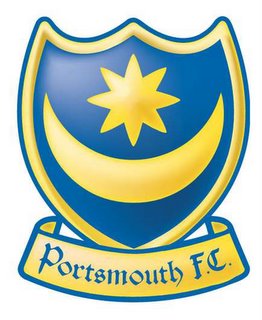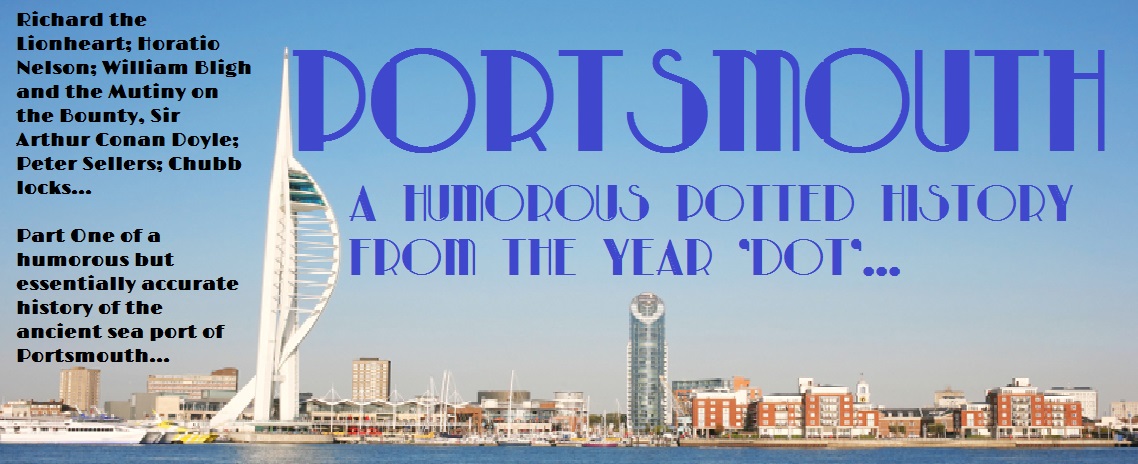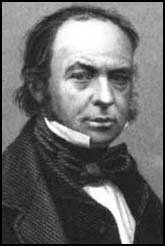or...
" Did you know that,
not a lot of people know that....
.... In the beginning for centuries upon centuries and possibly upon even more centuries than that, the island of Portsmouth (yes, it really is an island, separated from mainland England by a stretch of water called; 'Portscreek'), was nothing more than a rather small, yukky and inhospitable piece of swampland property which was of no particular interest to anybody... (except perhaps for single celled swamp beings who enjoyed living in yukky swamps!).
Down through the ages however, Portsmouth slowly evolved from its early yukky swampy days into one of the major south coast cities of modern England and an eminently beautiful holiday resort.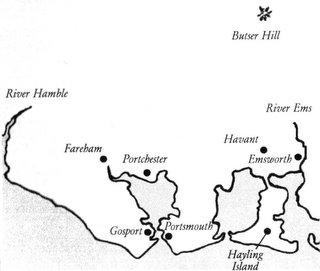
Undoubtedly Britain's premier naval port and the home of the most historic naval Dockyard in the world, Portsmouth is also the name of a proud region that extends to the River Hamble in the West, the River Ems in the East and to the slopes of Butser Hill in the North and also includes the harbour communities of Gosport and Emsworth, as well as the ancient Towns of Havant, Hayling Island and Fareham.
But what of the history of the Portsmouth Region? When did all that 'in the beginning' stuff begin? And, what were the ages of the aforementioned 'down through the ages' bit?...
Well, once upon a very long time ago, sometime after....
The Year dot BC...
 ... when evolution had done its bit, the first regional settlers arrived. They were of course, the Dinosaurs who, after several hundred million years of failing to see the potential of developing the area into some sort of Jurassic theme park, became extinct.
... when evolution had done its bit, the first regional settlers arrived. They were of course, the Dinosaurs who, after several hundred million years of failing to see the potential of developing the area into some sort of Jurassic theme park, became extinct.
And then somewhere between...
250,000 and 200,000 BC...
.... droves of Homo Erectus began to migrate from Europe, following the herds of game upon which, as hunter gatherers, they were so dependent, and exploiting the region for all it was worth, (which, at that time, probably wasn't much more than about 50p).
which, as hunter gatherers, they were so dependent, and exploiting the region for all it was worth, (which, at that time, probably wasn't much more than about 50p).
Naturally, in those far off days, the area, (still pretty inhospitable), would not have been known as 'The Portsmouth Region' so it's quite likely that, to Mr & Mrs Erectus, the region would doubtless have been known as; 'Uggmouth'.
And then - taking a quantum leap forward - in about...
40,000 BC...
 .... the first Homo Sapiens-Sapiens, (the upwardly mobile forerunner and model for the modern human, and er.... huwoman), appeared in Europe and, like Homo Erectus, also migrated to the region where they finally settled and continued to evolve.
.... the first Homo Sapiens-Sapiens, (the upwardly mobile forerunner and model for the modern human, and er.... huwoman), appeared in Europe and, like Homo Erectus, also migrated to the region where they finally settled and continued to evolve.
Minding their own business, these European migrants created settlements and quietly got on with taming animals, growing corn, bartering, fighting among  themselves, burying their dear departed Chief's in barrow's, (no, not wheelbarrow's! Earth barrow's, which are early graves), constructing wooden carts and building humungous stone things that seemed to serve no purpose whatsoever. (Like for example; Stonehenge)....
themselves, burying their dear departed Chief's in barrow's, (no, not wheelbarrow's! Earth barrow's, which are early graves), constructing wooden carts and building humungous stone things that seemed to serve no purpose whatsoever. (Like for example; Stonehenge)....
.... And then approximately 39,000 years later, (give or take a millennium or two), in about...
1000BC...
..... the non-migratory European's obviously became bored and so decided to start their 'hey, let's invade and conquer another Country' period
 And so it was that a bunch of tall, fair haired Celts called Bretons sailed across the channel from France and, after a quick invading and conquering session, decided to settle, then fell in love with, and ended up conjugating with the native regional tribes-persons, who's offspring naturally became; 'Celtic-Bretons'.
And so it was that a bunch of tall, fair haired Celts called Bretons sailed across the channel from France and, after a quick invading and conquering session, decided to settle, then fell in love with, and ended up conjugating with the native regional tribes-persons, who's offspring naturally became; 'Celtic-Bretons'.
A thousand or so years further on, just as the region was settling down and getting used to the idea of being Celtic-Breton's, just as everyone believed all that European invading and conquering stuff was over, who should come along and spoil it all but the Roman's who, in...
43AD...
... by order of Emperor Claudius, and without even so much as an 'excuse me' or a 'by your leave', invaded and conquered our green and pleasant lands and named our Country; 'Britannia', (an apparent spin-off of Breton). which meant of course that all Celtic-Breton's were now classed as Celtic-Briton's/British.
In the Portsmouth region, the Romans established a military post at a place they named Portus Adurni, (Portchester) and, although there is no direct reference to it, were very likely the very first to give the little yukky swampy island settlement that neighboured it, the name of 'Portesmutha'.
(In fact it is generally believed that Portchester is actually the 'Mother' of Portsmouth).
 Over the next 300 years or so of occupation, the Roman's founded regional settlements, set up coastal defences, constructed really fabby Villa's, laid miles of straight roads, introduced bathing and sanitation, built whopping great long walls and also fell in love and conjugated with the local Celtic-Brits, who's offspring then became known as; 'Romano-British'
Over the next 300 years or so of occupation, the Roman's founded regional settlements, set up coastal defences, constructed really fabby Villa's, laid miles of straight roads, introduced bathing and sanitation, built whopping great long walls and also fell in love and conjugated with the local Celtic-Brits, who's offspring then became known as; 'Romano-British'
Then, would you believe it, after three centuries of Roman rule, just as everyone was settling down and getting used to being Romano-Brits, after enjoying the Roman's fearless rock solid protection from invasion and attack by any other would be south coast pilfering pirates, such as the Danes and the Saxons etc, what does the Roman Empire do?
It starts to crumble that's what it does, which led to one Roman Legion after another upping kilts, and heading for Rome sweet Rome. (No doubt singing: "Be it ever so crumbling, there's no place like Rome"),
and so it was that by....
409AD...
.... the whole Roman kit and caboodle had gone leaving the poor old regional Romano-Brits to fend for themselves, which they did quite well, staving off seaborne attacks by the Angles, Jute's, Danes and Saxons. Oh yes, they really did quite well. That is, up until...
495AD...
... when the real Saxon conquest began with an invasion led by two warrior chiefs; Cerdic and his son, Cynric who landed from a small fleet of ships somewhere on the New Forest side of Southampton.
This was followed by the Saxon invasion of Portsmouth which began in...
501AD...
 ... when, according to the Anglo-Saxon Chronicles, (and this is obviously not an exact, 'word for word' account), "... a body of dirty great hairy, and frighteningly bloodthirsty Saxons landed at a place which is called 'Portesmutha' from two large galleys under the command of Port and his two sons, Bieda and Maegla".
... when, according to the Anglo-Saxon Chronicles, (and this is obviously not an exact, 'word for word' account), "... a body of dirty great hairy, and frighteningly bloodthirsty Saxons landed at a place which is called 'Portesmutha' from two large galleys under the command of Port and his two sons, Bieda and Maegla".
(This, apparently, is the earliest recorded historical reference to the actual island of Portsmouth).
Bravely, the 'Portesmuthian' Romano-Brits, (concluding these rather boisterous, happy-go-lucky Saxon's weren't simply a party of fun-seeking holidaymakers), drew themselves up and opposed them. Unhappily to no use.
The Saxon's attacked and, using their favoured weapon, the shortsword, (which was quite  obviously not short enough!), defeated the local Romano-Brits, killed their commander, took possession of the adjoining country and founded settlements all over the Portsmouth region.
obviously not short enough!), defeated the local Romano-Brits, killed their commander, took possession of the adjoining country and founded settlements all over the Portsmouth region.
And, for the next 600 years of Anglo Saxon rule, (as you have probably guessed by now), they fell in love and conjugated with the Romano-Brits who's offspring presumably became; Anglo-Saxon-Romano- Brits.
Then, just as everyone was settling down and happily getting used to being Anglo-Saxon-Romano-Brits, after enjoying their fearless rock solid protection from invasion and attack by any other would be south coast pilfering pirate...
(Wait just a mo' isn't this beginning to sound just a tad too familiar)... along come the perishin' Norman's who in....
1066AD... (900 years incidentally, before England won the World Cup at Wembley!!!)
 .... led by William, 'Billy the Conk' the Conqueror, invaded, defeated and killed our beloved Saxon ruler, good King Harold, by giving him one, (an arrow that is), in the eye.
.... led by William, 'Billy the Conk' the Conqueror, invaded, defeated and killed our beloved Saxon ruler, good King Harold, by giving him one, (an arrow that is), in the eye.
Thus ended Anglo-Saxon rule and a pretty lengthy Norman rule began.
And, naturally, just like all the others, they also did the falling in love and conjugating bit which made the regional Anglo-Saxon-Romano-Brits, er... well pretty confused probably!
Anyway, 20 years into his reign, in...
1086...
... King William, being a pretty frugal sort of bloke, ordered the compilation of the Domesday Book in order to provide a proper basis for taxation which, much like the old Poll Tax, (well any tax really), proved pretty unpopular. Basically, it listed all the taxable properties of England. All that is except Portsmouth which was so insignificant it didn’t even rate a mention!
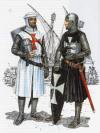 Not that it mattered because, ultimately, the Norman's, and in particular 'Billy the Conk's' Royal descendant's King Richard and King John, (without whom a certain Mr. Robin Hood and his merry men would never have got their, 'rob the rich and give to the poor' scheme off the ground), did actually do the then tiny, but growing island settlement of Portsmouth and its future Dockyard a lot of good.
Not that it mattered because, ultimately, the Norman's, and in particular 'Billy the Conk's' Royal descendant's King Richard and King John, (without whom a certain Mr. Robin Hood and his merry men would never have got their, 'rob the rich and give to the poor' scheme off the ground), did actually do the then tiny, but growing island settlement of Portsmouth and its future Dockyard a lot of good.
But not at first.
In fact, development-wise, the area was practically ignored until the 12th c. when it was acquired by the actual founder of Portsmouth, a wealthy Norman merchant by the name of Jean de Gisors.
The Development of Portsmouth Town
and its Dockyard.
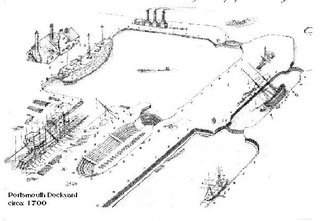
In 1100 and um... something or other AD...
... the southernmost part of Portsmouth was still quite marshy and pretty inhospitable.
Even so, the area really attracted Jean de Gisors. 
Not least because it had a sheltered inlet; a deep water channel protected by a shingle spit that provided a natural harbour and safe haven for his ships and which still exists today and is known as the Camber area.
(The Camber can still be found at the end of Broad Street in Old Portsmouth).
So, anyway in...
1182AD...
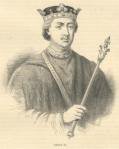 ... Henry Plantagenet II, King of all England, (oh, and of the French territories of: Normandy, Anjou, Poitou, Guienne, and Gascony), sailed from Portsmouth to France to pacify his son Prince Richard who, along with his friend and ally Philip II Augustus, (King of the rest of France), was currently rebelling against him.
... Henry Plantagenet II, King of all England, (oh, and of the French territories of: Normandy, Anjou, Poitou, Guienne, and Gascony), sailed from Portsmouth to France to pacify his son Prince Richard who, along with his friend and ally Philip II Augustus, (King of the rest of France), was currently rebelling against him.
Before sailing however, Henry made his will at Portsmouth, (which was just as well really because he died in France in 1189 and so never returned to England). In the meantime in...
1187AD...
... Jean de Gisors had laid out the beginnings of Portsmouth Town, developing streets and houses around the Camber area and also founding and financing the church of St. Thomas, dedicated to the martyred St. Thomas a'Becket who was murdered by four Knights of King Henry II in 1170.
(Now Portsmouth's Cathedral of St. Thomas, it is the finest medieval building in the City).
And then in...
1189AD...
 ... following the death of his father, Henry II in France, Richard returned to England, landing at Portsmouth on the 12th August as King of England, (and of course, Normandy etc), and, shortly after, in...
... following the death of his father, Henry II in France, Richard returned to England, landing at Portsmouth on the 12th August as King of England, (and of course, Normandy etc), and, shortly after, in...
1190AD...
... set off with Philip Augustus II on the third leg of the Crusades. (The first leg resulting in a win but the second leg being a bit of a wash out apparently).
And who knows if a heavyhearted Jean de Gisors himself might not have watched his Monarch's embarkation, waving a hand in tearful and loyal farewell.
He might have... But um... he probably didn't! 
You see, Prince John, the crusading King's rotten, scheming and cowardly brother saw Richard's absence as a definite career opportunity, and so rebelled against Richard and attempted to claim the throne of England for himself!
And guess who Jean de Gisors chose to support?...
Uh-huh!
This proved to be a whopping great big boo-boo on the part of Jean de Gisors because, when Prince John failed in his attempted coup, it resulted in poor old Jean being forced to forfeit his lands, including his beloved Town of Portsmouth, to King Richard in 1194. Bad news for dear Jean... But good news for Portsmouth! For in that same year of...
1194AD...
... good King Richard again visited Portsmouth but this time on his way to sort out his one time friend and ally, Philip II Augustus who had nicked most of Richard's French property.
 It was then that he granted his 'new' Portsmouth Town its first Charter; an historical event recorded in the Curtis Regis Rolls which states; " It pleased the Lord King Richard to build this Town of Portsmouth "
It was then that he granted his 'new' Portsmouth Town its first Charter; an historical event recorded in the Curtis Regis Rolls which states; " It pleased the Lord King Richard to build this Town of Portsmouth "
Naturally that didn’t mean he rolled up his sleeves and got stuck in  himself with the old bricks and mortar, but he did order the building development of the Town. And he further ordered the construction of a military installation and, (a quick roll on the drums)... a dock!
himself with the old bricks and mortar, but he did order the building development of the Town. And he further ordered the construction of a military installation and, (a quick roll on the drums)... a dock!
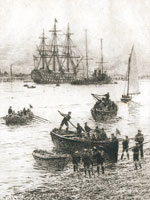 The question is; why would Richard, 'Coeur de Lion', (who, by the way, wore three lions on his shirt long before our beloved English Football team did), who regarded England as merely a useful inheritance on which to raise money for his crusades, who managed to visit England only twice during his 10 year reign and who could only speak French, bother to build a dock in Portsmouth?
The question is; why would Richard, 'Coeur de Lion', (who, by the way, wore three lions on his shirt long before our beloved English Football team did), who regarded England as merely a useful inheritance on which to raise money for his crusades, who managed to visit England only twice during his 10 year reign and who could only speak French, bother to build a dock in Portsmouth?
Well, firstly he appreciated the immense strategic value of Portsmouth's deep natural harbour and secondly, building such a dock gave him a perfect base for his ships which in turn allowed him to pop across the channel whenever he fancied, to check out his property or mount attacks on France!
Sadly, the legendary King Richard never had the chance to make proper use of his Portsmouth dock because he was killed in France by a stray arrow in April 1199, which meant of course that bad Prince John became King of England... (major bummer!)
However, although John was a nasty, swindling, conniving, devious, (and those were his good points), pretty unloved Monarch, he was not stupid and, like King Richard, could see the potential of having a Dockyard in Portsmouth.
In fact, King John was one of the most frequent of all Royal visitors to Portsmouth and in...
1205AD...
... gathered an amazing fleet of 500 ships in Portsmouth harbour for an expedition to France in order to prevent Philip II Augustus, (yes, him again), from conquering Normandy and all the other parts of his Kingdom in France.
Unfortunately, the expedition had to be abandoned because several nobles who were supposed to take part had a fit of the 'sucky-thumb' tantrums and refused to go, resulting in John losing all his French property!
Nevertheless, by this time, Portsmouth had grown from an 'in the beginning' insignificant yukky swampy island into a great shipbuilding centre and, due to its magnificent harbour, was the principal naval base of the Kingdom. In fact, by...
1212AD...
... it is a pretty safe bet to say that Portsmouth had its first proper Dockyard.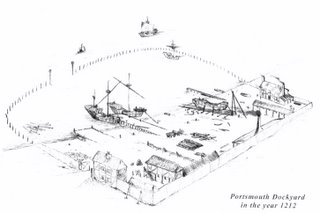
Proof of this comes in the form of a written Royal command from King John to the Sherriff of Southampton stating;
"We order you, without delay, by the view of lawful men, to cause our Docks at Portsmouth to be enclosed with a Good & Strong Wall in such manner as our beloved and faithful William, Archdeacon of Taunton will tell you, for the preservation of our Ships & Galleys: and likewise to cause penthouses to be made to the same Walls, as the same Archdeacon will also tell you, in which all our Ships tackle may be safely kept; and use as much dispatch as you can, in order that the same may be completed this summer lest in the ensuing winter our Ships & Galleys and their Rigging should incur damage by your default; and when we know the cost it shall be accounted to you'.
(This of course is an early form of Cash on Delivery).
Although John had a reputation for being a bad King, he did have a genuine and abiding interest in naval affairs and was undoubtedly a major player in the historic shaping of Portsmouth Town and its Dockyard.
And, albeit his particular docks were short-lived, (in May 1228, the docks were flooded by the sea and ordered to be filled in), it has to be said that the first humble beginnings of the 'Royal' Portsmouth Dockyard had certainly begun, thanks largely to King John who in...
1216AD
... died.
He was succeeded by his son, Henry the Third, who was only nine at the time and who reigned for an amazing fifty-six years, (for some of that time, setting sail from Portsmouth to France, determined to regain the lands lost by his father King John which, he eventually succeeded in doing). Anyway, Henry died in...
1272AD...
... and so began the 105 years reign of Edward's I, II & III. Those years were ticklish times for Portsmouth as the Town was often raided from the sea by Cinque port Pirates and also by the French who in 1337; 1369 and 1372, attacked, looted and then burned the Town to the ground. However in...
1385AD...
... the rather miffed citizens of Portsmouth Town had their revenge when, at their own expense, they fitted out a small squadron of ships, then set out and engaged and defeated several French squadrons before continuing on across the channel to the Seine and giving the shocked French a right royal, and well deserved, thrashing in their own back yard!
Although at that time, Portsmouth was a favourite port for seaborne attack and for British naval embarkation, very little it seemed was actually being done to improve and develop the Dockyard.
That is until...
1431AD...
... when King Henry V ordered that land be bought for the enlargement of the (Portsmouth) Dockyard, to be called; 'The Kings Dock'. Even so, it wasn't until...
1495AD...
 ... that the Dockyard really came into its own. This was the time of King Henry VII, a monarch who so seriously appreciated Portsmouth's obvious advantages as a naval and shipbuilding base, he instructed one Robert Brygandine, (Clerk of the Ships), to make a dry dock at Portsmouth, (sealing once and for all, Portsmouth's destiny as being a major Naval Dockyard and Port).
... that the Dockyard really came into its own. This was the time of King Henry VII, a monarch who so seriously appreciated Portsmouth's obvious advantages as a naval and shipbuilding base, he instructed one Robert Brygandine, (Clerk of the Ships), to make a dry dock at Portsmouth, (sealing once and for all, Portsmouth's destiny as being a major Naval Dockyard and Port).
And so it was, on the 14th June 1495, that work began on the first ever British dry dock.
The bulk of it was made of wood and it took 46 weeks to build at a princely cost of: £193. 0s. 6 3/4d.
And on the 25th May in...
1496AD...
... the 600 ton Sovereign was the first ship to use Portsmouth's dry dock.
She was followed by the Regent, the Sweepstake and the Mary Fortune. And then, in...
1509AD...
... Henry VII died and was succeeded by the legendary, multi-married, Tudor monarch himself, Henry ('off with her head') the Eighth.
 That same year saw the building, in Portsmouth Dockyard, of the warship; Peter Pomegranate, which was followed by the construction of one of the most celebrated ships in the world; the Flagship of Henry's Navy; the mighty Mary Rose!
That same year saw the building, in Portsmouth Dockyard, of the warship; Peter Pomegranate, which was followed by the construction of one of the most celebrated ships in the world; the Flagship of Henry's Navy; the mighty Mary Rose!
And two years later in...
1511AD...
... Portsmouth was officially designated as the major building centre for the Kings ships.
As for the .Mary Rose, (Henry's prized ship), well, she served for over 30 meritorious years before that fateful day in...
1545AD...
... when she, along with almost the entire English fleet, (which was anchored  in the Solent), set sail and prepared to face a French, (yes, them pesky varmints again), invasion of 200 ships.
in the Solent), set sail and prepared to face a French, (yes, them pesky varmints again), invasion of 200 ships.
Watched in utter horror by King Henry himself from the ramparts of Southsea Castle, the Mary Rose suddenly slewed over, capsized and sank taking 400 crew with her.
By the King's order, many attempts were made to salvage her, but all to no avail.
(In fact, she didn't again see the light of day until over 400 years later when, in October 1982, her hull was raised and the Mary Rose was at last returned home to Portsmouth Dockyard, the place of her birth).
By the time of the tragic sinking of the Mary Rose, Portsmouth was already a heavily fortified garrison Town & naval port and, Britain's premier shield against invasion from France. Her Dockyard too had also become something of a pretty industrious shipbuilding complex.
That is until about...
1547AD...
 ... during the reign of Edward VI, when things went a wee bit stagnant.
... during the reign of Edward VI, when things went a wee bit stagnant.
In fact, to put it bluntly, for the next century, Portsmouth and her Dockyard went downhill faster than a greyhound on a skateboard!
And there was much wailing and gnashing of teeth, what with the Plague of 1563 & the English Civil war of 1642 and all!
However, by...
1665AD...
... major redevelopment was afoot. 
 On the throne was Charles II, (who on May 21st 1662, married his Queen; Catherine of Braganza in Portsmouth in the church known as; 'The Domus Dei', (which was founded circa 1212 and is now 'The Royal Garrison Church'. )), and a famous Dutch engineer; Sir Bernard de Gomme, was charged with the job of re-planning the fortifications of the Town & Dockyard.
On the throne was Charles II, (who on May 21st 1662, married his Queen; Catherine of Braganza in Portsmouth in the church known as; 'The Domus Dei', (which was founded circa 1212 and is now 'The Royal Garrison Church'. )), and a famous Dutch engineer; Sir Bernard de Gomme, was charged with the job of re-planning the fortifications of the Town & Dockyard.
Portsmouth was on its way up at last! And by...
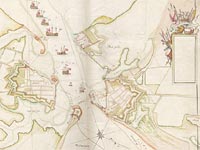 1670AD...
1670AD...
... King Charles had created the first proper, bona-fide Royal Navy and had further initiated the major expansion of Portsmouth Dockyard which continued on into the reign of William III.
And so by...
1698AD...
... the Great Ship Basin, (No 1 Dock), and No 5 Dock had been built, followed two years later by No 6 Dock.
Oh yes, on the development side, things were definitely on the up!
And so, incidentally, was the intake of Dockyard workers, sailors and, naturally, their families.
So much so in fact that by the reign of Queen Anne in...
1703AD...
... a new Town had begun to spring up outside the ramparts of Portsmouth Dockyard to house the growing workforce and their kin.
This new Town was known as Portsea and within 100 years, its population had surpassed that of the old walled Town of Portsmouth! (Why do rabbit's come to mind?).
In fact, everything was expanding. Including the Dockyard which by...
1733AD...
... had increased its size by 10 1/2 acres, had a new Dockyard wall erected, and was, in itself, a 'Town within a Town' with its own church, stables, smithery and houses.
There was also an established Naval Academy for the education of; 'forty young gentlemen, sons of nobelmen and gentlemen' who were taught French, Drawing, Fencing and the use of the Firelock.
(It's a shame the Academy didn't also teach these young snobby, wealthy and spoilt young 'gentlemen' who very soon gained a rep for idleness, swearing and drunkenness, how to act like, well.... gentlemen!)
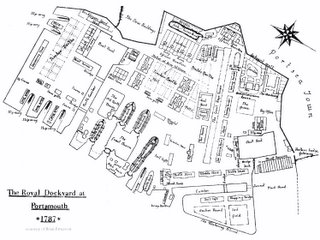
Anyway, in...
1797AD...
 ... war, (with... guess who?.... yes, that's right... France); was at its height. 'Mad' King George III was on the throne and Admiral Lord Nelson was a major hero.
... war, (with... guess who?.... yes, that's right... France); was at its height. 'Mad' King George III was on the throne and Admiral Lord Nelson was a major hero.
And Portsmouth?
Well, Portsmouth was now Britain's foremost naval station and her Dockyard had become the worlds largest, self contained industrial complex .
Not bad for a one time, insignificant yukky swampy little island, eh?
Particularly as in...
1800AD...
... Portsmouth Town was a truly exhilarating place to be. The 19th century was, after all, an incredibly romantic and fascinating period.
Britannia ruled the waves and it was a time rich in invention, royal madness, naval glory and.... Piracy!
And so it was that, in Portsmouth Town...
Hmm, well methinks that's another exciting story, for another day...
